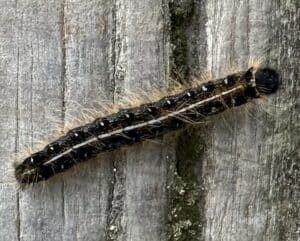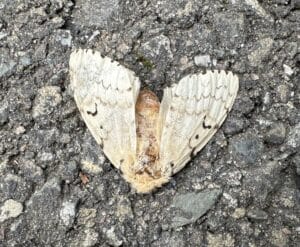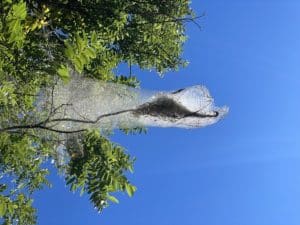Hello fellow lovers of all things green, They’re back! While visiting the Karen Ann Quinlan Home for Hospice for our weekly volunteer sing, the larvae of spongy moths, formerly called gypsy moths, were slithering along the sidewalk. Ken Roberts, my dear friend and partner in providing music therapy, asked if they make tents in the trees.
“I don’t think so. Let me ask Mary,” I giggled.
The Larvae of Spongy Moths, Tent Caterpillars, and Webworms look similar.

Spongy Moth Larva
Spongy moths don’t make the silky tents in trees we see in the spring and fall, though the creepy crawlies (the larvae) look similar. They lay their egg masses on tree trunks, branches, and other surfaces such as firewood, lawn furniture— even under car bumpers and wheel wells. Ick!
Fall webworms (Hyphantria cunea) pitch their tents around branches in the late summer or early fall and feed on them while “camping.” Thus, their tents are filled with fecal droppings and food remnants. In comparison, Eastern tent caterpillars (Malacosoma americanum) make their tents in the spring in a fork of branches and then leave their campsites to eat leaves of nearby trees, returning in the evening or during rainy weather to hunker down. So, their abodes are “tidier.”
Tent Caterpillars and Webworms rarely kill trees or shrubs.
While they both can significantly defoliate, they usually won’t kill trees, unlike spongy moths. If need be, you can destroy the nests by dropping them into soapy water. Or use a safe-for-the-environment contact insecticide such as Bacillus thuringiensis (Bt)—a naturally occurring bacterium common in soils.

Eastern Tent Caterpillar Nest
BT is a selective insecticide that kills caterpillars while being safe for other wildlife. Apply the spray directly to foliage and tent nests. It produces proteins that react with the cells of the gut lining of susceptible insects, causing them to stop feeding within hours. They then die from starvation—not very kind. Maybe it’s best to just let them be.
Think of them as diehard campers with a nifty lifecycle instead of a threat. Besides, native insects are a food source for our beautiful birds, adorable toads, and other beneficial insects. It’s true; they can be unpleasant when they fall on your plate at a barbeque.
Whereas Spongy Moths can devastate plants.

Spongy Moth
Native to Eurasia, unlike many unfavorable insects that arrive here accidentally, gypsy moths (Lymantria dispar disparla) were brought here intentionally in the 1860s as a possible source of silk fiber when the traditional silk moth became diseased. Gypsy moths are now called spongy moths due to their spongy egg masses.
Their favorite host is Oak, though they love to feed on many species of trees. Last June, my clients’ oak trees in Glen Spey, NY, were leafless. The leaves grew back later that summer once the spongy moth caterpillars stopped feeding. A healthy tree can survive two or three consecutive defoliation attacks, but it weakens the tree, making it more susceptible to drought, other environmental problems, or pests.

Fall Webworm nests look like cotton candy decorating trees.
I wish I had a DIY solution for spongy moths, but management requires hiring a progressional. I spoke with my associate arborist, Dave Dubee, who said they use BT, requiring an industrial sprayer. There are chemical remedies, too, but we must consider the environmental impact.
Why did the name change from Gypsy Moth?
Why the name change? The Entomological Society of America dropped the common names of the gypsy moth and the gypsy ant because “the names are inappropriate and offensive. The Romani people, or Roma, are Europe’s largest ethnic minority and face discrimination. Gypsy is considered a pejorative term.”
I always thought that the definition of a gypsy is somebody who moves from place to place in an adventurous kind of way. My mother called me a gypsy when I was on the move during my twenties, bringing my belongings and sending others forward through UPS. It just shows that names can mean something favorable to one group and offensive to another. But surely defoliated and dying trees are sad to see and displeasing to all.
Garden Dilemmas? AskMaryStone@gamil.com and your favorite Podcast App.
There’s more to the story in the Garden Dilemmas Podcast
Links to Related Posts and Podcasts
Fall Webworm vs. Tent Caterpillars – Blog Post
Ep 71. Diehard Campers – Tent & Webworms
Rose is a Rose Pest Remedies – features my brother Rick’s hilarious dilemma


